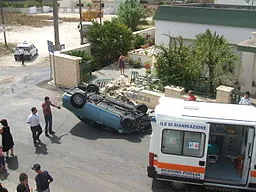Rollover crashes remain one of the most deadliest of collisions. One of the reasons they remain so deadly is due to roof crushing that occurs after the rollover.
In some cases, the fatality occurs when the roof of the vehicle hits the ground, crushes inward toward the vehicle occupants and strikes them. The other scenario that occurs with roof crushing is the windows, windshields or doors break or open up when the roof hits the ground.. The now deformed shape of a vehicle has wide gaps that can cause the vehicle occupants to be ejected from the vehicle.
The U.S. government passed a law in 1973. Part of the Federal Motor Vehicle Safety Standard Act. (Part 216) required vehicle manufacturers to build vehicles that were ‘roof crush (resistant) over the passenger compartment.’ This was a good start but sadly this rule changed little in the vehicle manufacturing world. As seen by the direct quote of the act, the rule was quite broad. It only told the manufacturers to consider the strength of the roof but provided no specific guidelines.
After hundreds of thousands of needless deaths due to rollover roof crush accidents, it became evident that there needed to be better guidelines to enforce manufactures of automobiles to improve the strength of automobile roofs to withstand the crushing that occurs in the case of a rollover collision. This led to the modification of the Federal Motor Vehicle Safety Standard 216 in 2009.
This updated guideline requires the automobile manufacturers to perform strength-to-weight ratio tests. The roof structure must withstand 1.5 times the vehicles unloaded weight to 3.0 times the vehicles unloaded weight. As you can see, this rule still allows for car manufacturers to make cars with roofs of greatly varied strengths. The modified rule also required vehicle manufacturers to perform two-sided tests rather than a single-sided test. Finally, it established some requirements for vehicles to have sufficient ‘headroom.’ The extra headroom provides the occupants some survival space in the case of a rollover.
Below is a video demonstrating how these roof crush tests are performed and demonstrates the huge difference in how vehicles hold up under testing. Both vehicles were subjected to the same force but one of the vehicles had roof crush of only two inches while the other sustained roof crush of fifteen inches!
Additionally, experts state even with the new rule of 1.5-3.0 times the weight, this amount is still woefully inadequate. Most auto manufacturers are aiming only to pass at 1.5 times the weight. Experts believe that roofs need to be at least 4.0 the strength-to-weight ratio. If you are interested in learning where you car rates with the crash test safety ratings, you can use this link: http://www.safercar.gov/.
It should be noted there are still no rules in place regarding rollover-resistance standards and automobile manufactures.
Notwithstanding these updates to the roof crush safety laws, tens of thousands continue to die each year due to roof crush. If you were injured in an auto accident, or a loved one was killed during a rollover accident involving a crushed car roof, please contact an auto injury attorney at the Edward A Smith Law Offices (AutoAccident.com) for a free, no-obligation review of your case. You can also call us toll-free at 800-404-5400 and speak to vehicle injury attorney, Edward A Smith. If you want to learn more about our office prior to calling, please look at our website www.autoaccident.com and see what clients are saying about our office on Yelp or Avvo. We look forward to being able to help you with your questions.
Photo Attribution: By Quatar (Own work) [GFDL (http://www.gnu.org/copyleft/fdl.html) or CC-BY-SA-3.0 (http://creativecommons.org/licenses/by-sa/3.0)], via Wikimedia Commons

